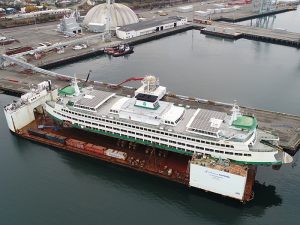
Everett Ship Repair starts work on WSF Jumbo Mk III
Everett Ship Repair LLC (ESR) has issued some more details and photographs of the work it is undertaking on Washington State Ferries’ M/V Wenatchee. The vessel is a Jumbo Mark II class

Everett Ship Repair LLC (ESR) has issued some more details and photographs of the work it is undertaking on Washington State Ferries’ M/V Wenatchee. The vessel is a Jumbo Mark II class

On November 10, Matt Williams, program manager at Portland. Ore.-based Vigor, will give a presentation at Marine Log’s free virtual FERRIES 2020 conference that features highlights and progress on the new hybrid
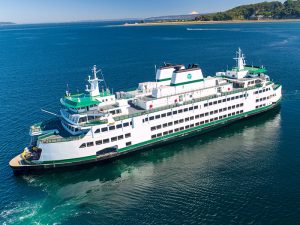
ABB has been selected by Vigor Fab LLC to provide hybrid-electric propulsion and energy storage system solutions for the newest additions to the Washington State Ferry fleet, setting the largest U.S. ferry
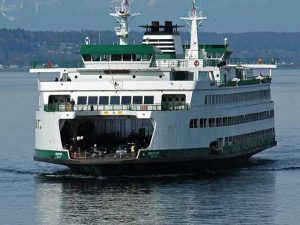
Washington State Ferries has moved a major step forward on its long planned conversion of its three Jumbo Mark II class ferries, the largest in the fleet, from diesel to hybrid electric
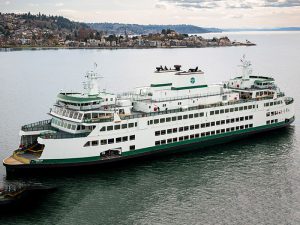
JANUARY 3, 2019 — More than half of Washington State Ferries’ 23-vessel fleet is scheduled to be retired by 2040. The ferry system needs 16 new vessels in the next 20 years,
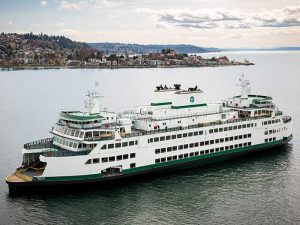
APRIL 8, 2017 — Washington State Ferries yesterday officially accepted Chimacum, the newest addition to the state ferry fleet, from shipbuilder/contractor Vigor. The Chimacum will carry ferry riders on the Seattle/Bremerton route
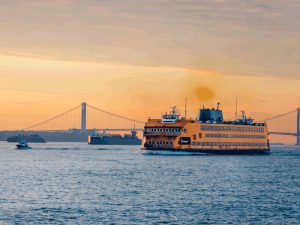
Considered the “forgotten borough” by some New Yorkers, Staten Island is on the verge of making its presence known in the city that never sleeps. The borough is a 25-minute ferry ride from the lowest tip in Manhattan, the Staten Island Ferry terminal at Whitehall.
Staten Island’s plan for renewal includes a $1.2 billion investment that will see the construction of the New York Wheel at St. George—an impressive 630 ft tall observation wheel that will rival England’s infamous London Eye, and feature 36 pods with accommodations for 40 in each, on a 38 minute ride/revolution, giving passengers a spectacular view of New York Harbor. Alongside the New York Wheel, New York City’s first outlet mall, Empire Outlets, is currently being constructed at St. George. The mall will feature 350,000 square feet of retail, 100 different shops and a 190-room hotel. Both the New York Wheel and Empire Outlets are expected to be operational by 2018.
How will tourist, potential shoppers, and New Yorkers alike make their way to these new attractions? They’ll be taking the Staten Island Ferry of course. The fleet, currently comprised of nine ferries, carries 22 million passengers a year—second only to Washington State Ferries’ fleet which carries over 23 million passengers annually.
And come 2019, the Staten Island Ferry fleet will welcome a new class to its fleet—the Ollis Class ferries.
Designed by Seattle-based Elliott Bay Design Group, the Ollis Class will mix the new with a bit of the old, providing passengers with a faster, more efficient ride to help meet increased ridership demand.
Its design will give the 320 ft x 70 ft ferries a striking resemblance to the beloved John F. Kennedy—which was commissioned in 1965 and is one of the oldest ferries in the Staten Island Ferry fleet. The Kennedy is one of three-that will be retired once the new Ollis Class series is delivered—the S.I. Newhouse and Andrew J. Barberi, both commissioned in 1981 are the other two.
The new Ollis Class will be double-ended and have capacity for 4,500 passengers; and like the Kennedy, will feature plenty of open air space, enabling passengers to enjoy the harbor view. The ferries will be built to ABS class requirements and will be powered by Tier 4 EMD engines and Voith Schneider Propulsion Drives.
The first of the three ferries will be named in honor of U.S. Army Staff Sgt. Michael Ollis, a native Staten Islander who died while saving another soldier in Afghanistan. He was only 24 years old.
The Staff Sgt. Michael Ollis ferry is expected to begin operations in 2019, with vessels two and three following later in 2019 and 2020.
Building the Ollis Class
As we were going to press, yards were putting in their final bids for the ferry project.
Among the yards that have expressed interest in the Ollis Class—at least according to the 2015 Industry Day attendance—are Conrad Shipyard, Eastern Shipbuilding Group, Fincantieri Bay Shipbuilding, and Vigor. All are builders of a variety of vessel types including ferries.
Conrad Shipyard—which has won a number of newbuild contracts this year — has had its share of ferry projects in the past, and is looking to keep the momentum going.
As Dan Conrad, Conrad Shipyard’s Senior Vice President and Director, explains, “Conrad Shipyard has a great track record on deliveries to the Puerto Rico Maritime Authority, the Texas Department of Transportation, the State of North Carolina and the Alaska Marine Highway, among others.” And he assures that his team is committed to pursuing the ferry market for years to come.
Most recently, Conrad’s Conrad Aluminum, Amelia, LA, yard delivered the M/V Woodshole to the Steamship Authority. The 235 ft x 64 ft ferry was designed by Elliott Bay Design Group and has capacity for 384 passengers, 55 automobiles or 10 eighteen-wheel tractor-trailers.
Eastern Shipbuilding Group is said to have the inside track on building the Ollis Class ferries, according to our sources. It would be quite a month for the Panama City, FL-based shipyard, which recently secured the lucrative contract to build the OPC for the U.S. Coast Guard.
Meanwhile, Fincantieri’s recent expansion is helping it position its Bay Shipbuilding yard for larger projects that can be produced and worked on, year-round. The three-acre expansion will pave the way for additional covered fabrication and erection facilities, an indoor paint and coating building, and outfitting shop that will enable FBS to increase its pursuit of ferry projects.
“This expansion allows us to increase our capacity and positions us to pursue a number of new construction markets, including large passenger ferries,” said FBS Vice President and General Manager Todd Thayse. “Our experience in building ferries and other complex passenger vessels dates back to our origins almost a hundred years ago, and includes the New York Staten Island Ferry now operating (the Guy V. Molinari). We have the people, the experience, the facilities, and the global resources of Fincantieri to ensure that we can tackle the most challenging construction projects.”
As for the shipbuilding powerhouse in the Northwest, Vigor, it’s currently working on six ferry projects at the moment, including the final two vessels in Washington State Ferries’ new 144-car Olympic Class.
 “Vigor has deep expertise in the ferry market with successful, on-time and on-budget deliveries of car ferries, passenger only vessels and catamarans. Six ferries are currently under construction at our Washington and Alaska yards and we expect ferry construction to continue to be a focus in our business development efforts, leveraging our considerable experience,” said Corey Yraguen, Vigor Executive VP of Fabrication.
“Vigor has deep expertise in the ferry market with successful, on-time and on-budget deliveries of car ferries, passenger only vessels and catamarans. Six ferries are currently under construction at our Washington and Alaska yards and we expect ferry construction to continue to be a focus in our business development efforts, leveraging our considerable experience,” said Corey Yraguen, Vigor Executive VP of Fabrication.
Just last month the Chimacum, the third in the series was christened at Vigor’s Harbor Island yard. The fourth vessel in the series, the Suquamish, is currently under construction and scheduled for completion in 2018, with operations set to begin in 2019.
The 144-car ferries are the result of a combined effort from a consortium of Northwest based companies, including Nichols Brothers Boat Builders, Freeland, WA, which has been in charge of building the superstructures for the144-car ferries.
In other Vigor ferry news, Vigor’s Ballard Facility (formerly Kvichak Marine) is building two 400 passenger ferries for the Water Emergency Transportation Authority of San Francisco (WETA). The Incat Crowther designed ferries will travel 27 knots and are scheduled for delivery Summer 2017.
And Vigor’s Ketchikan yard in Alaska has taken up the task of constructing the highly anticipated 280 ft Day Boat ferries for the Alaska Marine Highway System. The ferries, designed by Elliott Bay Design Group, are scheduled to be completed Fall 2018.
Vigor’s Executive VP of Business Development, Keith Whittemore, will be discussing Vigor’s ferry projects and more at the Marine Log Ferries Conference & Expo November 3 & 4, 2016, Seattle, WA. Attendees of the event will also have the chance to tour Vigor’s Harbor Island yard after the conference’s conclusion. Learn more at www.marinelog.com/events
Route Extension?
Staten Island Borough President, James Oddo sparked additional interest in the Staten Island Ferry system when he requested the New York City Department of Transportation explore the feasibility of extending the Staten Island Ferry’s route north of the Whitehall Terminal, possibly extending the service into midtown.
While the idea sounds great in theory, and will certainly foster a sense of “transit equality” for Staten Islanders who have a grueling commute (just ask our Editor-in-Chief, John Snyder), the route extension could prove problematic as there is currently no operating terminal in place in midtown, with the right infrastructure to handle such large vessels.
 New York’s Ferry Boom
New York’s Ferry Boom
Of course, the Staten Island Ferry isn’t the only New York City ferry operation making waves. Operated by Hornblower NY, Citywide Ferry Service’s new fleet of ferries are currently under construction at Louisiana-based Metal Shark Boats and Alabama’s Horizon Shipbuilding. The contract catapults both yards into new markets—propelling Metal Shark into the commercial market in a very big way, and introducing Horizon to the ferry market.
A large portion of the Incat Crowther-designed ferries are expected to be delivered in time for Citywide Ferry Service’s launch Summer 2017. The service, according to the New York City Economic Development Corporation is projected to make 4.6 million trips annually.
The 85 ft ferries will have capacity for 150 passengers, as well as space for bikes, strollers and wheelchairs. The Citywide Ferry Service is expected to add five new routes on the East River.
Meanwhile, another well-known ferry operator in New York harbor is upping its stake in the market. Seastreak says its “raising the bar in fast passenger ferry service” with the addition of a new, high-speed, 600-passenger, catamaran in 2017. The ferry will be the highest passenger capacity USCG K-class high speed ferry in the U.S.
The addition of the new ferry will help Seastreak meet growing passenger demand on the New Jersey to New York route.
 Designed by Incat Crowther, the ferry, the first in Seastreak’s new Commodore class, will be 147 ft 8 in x 39 ft 5 in. The vessel was designed to provide Seastreak with an operational advantage. The ferry’s boarding arrangement will include large forward and aft side gates as well as an adjustable bow ramp. This will help facilitate turnaround times at terminals.
Designed by Incat Crowther, the ferry, the first in Seastreak’s new Commodore class, will be 147 ft 8 in x 39 ft 5 in. The vessel was designed to provide Seastreak with an operational advantage. The ferry’s boarding arrangement will include large forward and aft side gates as well as an adjustable bow ramp. This will help facilitate turnaround times at terminals.
The first vessel in the series will be built at Gulf Craft Shipyard, Franklin, LA. Construction is to be completed by 3rd quarter 2017. Meanwhile, Seastreak expects a keel to be laid for a second Commodore class vessel before the end of 2016.
The Commodore Class ferry will be powered by four MTU 12V4000 M64 EPA Tier III main engines, each delivering 1,875 hp at 1,800 rev/min and driving Rolls-Royce KaMeWa 63S4 waterjets. The vessel will also feature LED lighting and an advance energy efficient HVAC system.
The ferry’s main deck will hold 234- passengers; mid deck will seat 271 passengers inside and 52 passengers outside; and the third deck features 160 exterior seats as well as the vessel’s wheelhouse.
Seastreak is also initiating the upgrades and repowering of several members of its current operating fleet. First one up will be the Seastreak New York, which is expected to enter into drydock this coming winter. At press time, the bids were out to multiple yards. The repowering project is expected to be completed by the end of the 1st quarter 2017.
Florida gets in the game
New York isn’t the only city getting its ferry action on. This month, service officially begins on the Cross-Bay Ferry system—connecting St. Petersburg and Tampa, Fl. The service is part of a pilot project intended to introduce residents and visitors to water transit services in the area.
The route will be operated by the 98 ft twin-hull aluminum catamaran, Provincetown IV. The ferry was originally built for Bay State Cruise Company, Boston, MA, by Gladding-Hearn Shipbuilding, the Duclos Corporation, Somerset, MA. Designed by Incat Crowther, the 149-passenger ferry can operate at a top speed of up to 30 knots on the 50 minute route.
“We only have one vessel, and one crew, so we cannot do everything, but we do mean to showcase this technology to a lot of people and test ferry service in a variety of ways and markets,” said Ed Turanchik, policy advisor for the project.
Organizers of the project are testing the service on a variety of different market segments including tourist and local commuters, and the entertainment and sports markets. Learn more about the project at CrossBayFerry.com.
VDOT accepts ferry bids
Last month, the Virginia Department of Transportation was accepting bids for a new 70-vehicle ferry based on a design by Alion Science. The boat would be a replacement for the VDOT’s oldest ferry, the Virginia, built in 1936. Construction on the steel-hull ferry is to start this fall with completion in 2018.
Gladding Hearn delivers high-speed ferry
Gladding-Hearn Shipbuilding, the Duclos Corporation, recently delivered a new 493 –passenger, high-speed Incat Crowther designed ferry to Hy-Line Cruises, a division of Hyannis Harbor Tours, Inc., Hyannis, MA.
The all-aluminum ferry is 153.5 ft x 35.5 ft and is powered by four Cummins QSK60-M, EPA Tier 3 diesel engines each delivering 2,200 bhp at 1,800 rev/min. Each engine will power a Hamilton HM721 waterjet through a Twin Disc MG61500SC horizontally-offset gearbox.
Incat Crowther says the ferry represents an evolutionary step from its previous designs built by Gladding-Hearn. According to the designer, the capacity increase had to fit within docking constraints, enforcing upper limits on both the length and beam of the vessel. To meet the requirements, it moved the wheelhouse to a third deck, freeing up the front end of the second deck for VIP passengers.
The restructuring shifted boarding arrangements, with the addition of a middeck boarding door and both forward and aft stairways improving passenger flow and turnaround times, says Incat.
The ferry will provide year-round service between Hyannis and Nantucket Island. It will top speeds of over 34 knots when fully loaded at a deadweight of more than 64 tonnes, said Peter Duclos, President of Gladding-Hearn.
The new ferry is also outfitted with a Naiad Dynamic trim-tab, ride-control system to help improve passenger comfort and safety. The system’s motion sensor measures the relative movement of the vessel and transmits a signal to the hydraulic device to counter the boat’s actions through the waves.
Europe’s Ferry Market
The European ferry market remains in the forefront of technology. The continent that gave the world emission-free, battery operated ferries, will now give forth, the world’s largest hybrid ferry.
Just last month, Norway’s Color Line reported that it would order the largest hybrid ferry ever built. The ferry, which will feature batteries charged via green electricity from dedicated shore side facilities, or recharged on onboard via the ship’s generators, would double the capacity of the vessel it will replace.
Tentatively named the “Color Hybrid, the ferry will be 160 m long and have capacity for 2,000 passengers and up to 500 cars. The ferry is expected to be put into service on the Sandefjord, Norway to Stromstad, Sweden route in 2020.
 And not to be outdone, Damen says its ready to launch its first composites-construction Water Bus. As we were going to press, the prototype was prepping to begin sea trials.
And not to be outdone, Damen says its ready to launch its first composites-construction Water Bus. As we were going to press, the prototype was prepping to begin sea trials.
The Damen Water Bus is the first vessel for public transportation produced at Damen Shipyards, Antalya, Turkey. Its benefits are plentiful—the vessel, which features a slender hull, making it lighter than a traditional aluminum vessel, requires less fuel consumption, less maintenance, will suffer from no corrosion or fatigue problems. It can travel at speeds up to 21 knots and has capacity for 100 passengers.
Damen’s Design & Proposal Engineer, Fast Ferries, Marcel Elenbaas, explains that the Water Bus is built using high quality vacuum infusion technology that creates a “difficult to penetrate closed cell, epoxy sandwich structure.”
Damen says the vessel is ideal for highly congested urban areas, and is a simple and efficient way for using a city’s natural waterways system.
The Water Bus is equipped with two, forward facing, double-screw podded propulsion units—helping to reduce vibrations. Damen says the vessel can be easily adapted to customer specifications, and because of the nature of the composites’ production process, delivery to clients will be quick.
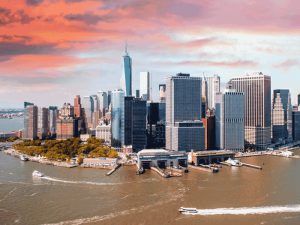
“Anyone studying the growth of the city …cannot help but be struck by the fact that New York was first a port before it was anything else.” This William Bixby quote adorns the perimeter of South Street Seaport in New York. The city is one with a rich maritime history—operations on both the East and Hudson River have played a vital role in shaping the city and its people’s history—but its one often forgotten by most New Yorkers navigating their way through the hustle and bustle of the concrete jungle.
New York was originally the landmass south of Wall Street on the island of Manhattan, as time went on, however, New Yorkers began expanding out into the neighboring boroughs and eventually made their way to the suburbs. Today, Manhattan is still the city’s center with New Yorkers spending, on average, 40 minutes traveling to or from work each day, according to the New York Times —more than any other city in the United States. But one mode of transportation often not used by New Yorkers, are ferries operating on New York’s marine highway, the East River. Granted, most communities in the city’s five boroughs don’t have access to such ferry operations—except for Staten Island which has the government operated Staten Island Ferry, most ferry operations are private and confined to Manhattan and parts of Queens and Brooklyn—but that’s all about to change thanks to a partnership between the New York City Economic Development Corporation (NYCEDC) and Hornblower, Inc.
Hornblower is no stranger to New York, the company’s subsidiary Statue Cruises currently provides transportation to the Statue of Liberty National Monument and Ellis Island. Hornblower also debuted its New York Hornblower Hybrid, a ferry/luxury yacht, back in 2011.
Citywide Ferry
Promising a fast, frequent and convenient service operating year round, the Citywide Ferry will bring a total of six routes that, when combined, will cover over 60 miles of waterways. The creation of the service will help meet growing waterfront community demand, and help lighten the load for an already overworked, overcrowded, and outdated MTA subway system.
Hornblower will have the option to purchase at least 17 new ferries, as well as chartering already existing ferries to help meet the system’s demand. Our sources tell us Hornblower will likely contract up to three shipyards, which will each build three to four ferries in the first round of construction. One of the shipyards is believed to be Metal Shark Aluminum Boats, Jeanerette, LA. It recently received a Small Shipyard Grant from the Maritime Administration for its Franklin, LA, shipyard.
The city is providing the service with $55 million in infrastructure upgrades—this includes the building of ten new ferry landings and the repair/refitting of six others. Additionally, the city will provide $10 million for startup costs, such as vessel upgrades and ticketing machines and $30 million in operation support per year for a period of six years.
NY Waterway’s East River Ferry boats are also to be fully integrated into the Citywide Ferry fleet. The transition is expected to be complete by the summer of 2017.
The Citywide Ferry service will roll out in two phases. Phase one will initiate service to Astoria, South Brooklyn and Rockaway in 2017. Phase two to Soundview (Bronx) and Lower East Side will launch in 2018.
The catamaran ferries, which will be based on an Incat Crowther design, say our sources, will carry at least 149 passengers, will be fully accessible to those with disabilities, will be equipped with WiFi, and will operate using low emission engines and “Low Wake” technology. The ferries will offer passengers 360 degree views, and LED screens will be fitted on board displaying information and entertainment.
The ferries, like its Staten Island ferry counterpart, will also offer food and beverage options on board.
However, unlike the Staten Island Ferry, which is free, the Citywide Ferry will cost passengers $2.75, the same price as a New York City Metro Card swipe on the city busses or Subway system.
Passengers however will not be able to transfer from the train/bus to the Citywide Ferry—meaning the service won’t be fully integrated with the NYC mass transit system. However, free transfers will be available between ferries. The ferries will operate from 6:30 am to 10 pm, seven days a week.
 Ferry Landings for Citywide Ferry
Ferry Landings for Citywide Ferry
A total of 10 ferry landings—the barges were designed by Blancke Marine Services, Woodbury, NJ, and the topside outfit by project design manager McLaren Engineering—will be built for the service, and are expected to be ready in time for the service’s launch in 2017. The barges for the landings are being built at May Ship Repair on Staten Island.The ferry landings will be 35 ft wide by 90 ft long.
The landings are being fabricated for Soundview, Bronx; Astoria, Queens; East 62nd Street, Manhattan; Roosevelt Island (between Manhattan and Queens); Long Island City, Queens; Stuyvesant Cove in Manhattan; Grand Street (Lower East Side Manhattan); Red Hook, Brooklyn; Bay Ridge, Brooklyn; and the Rockaways.
According to NYCEDC, upon completion, the landings will be equipped with canopies and wide screens to provide passengers a sheltered space from inclement weather. Additionally, the barges will feature ticket machines and waiting areas, allowing for minimal upload impact at the landing sites, says the NYCEDC.
Helping the waterfront community
The Citywide Ferry system is projected to add 155 new jobs to the New York Harbor. Additionally, the company will participate in the City’s HireNYC program which will match qualified applicants from neighborhood-based WorkForce1 training centers, meaning that the folks working at the landings will be qualified people from the communities.
Crews are expected earn more than $15 an hour and will also receive a comprehensive benefits package.
Further exemplifying its desire to highlight and foster the growth of the city’s maritime tradition, NYCEDC has partnered with a number of federal, state and city agencies to launch the Waterfront Navigator—a website that will serve as an official source of information for businesses and waterfront property owners seeking to learn what tools are available to them. In addition, the website, WaterfrontNavigator.NYC, will help facilitate environmental permit applications for waterfront construction.
NYCEDC President Maria Torres-Springer says that the “one-stop” user friendly website is where regulatory agencies from the federal, state and local levels joined forces to create a resource for simplified permit planning.
Staten Island Ferry
One constant presence on the New York Harbor has been the Staten Island Ferry (or at least some incarnation of it). Formal service on the route between Manhattan and Staten Island was established in 1817 under the Richmond Turnpike Company when it began sailing the steam-powered Nautilus. Eventually, the City of New York took over the operation in 1905 when it ordered five new ferries for the route, each named after the city’s five boroughs: the Bronx, Brooklyn, Queens, Manhattan and Staten Island.
Since then, a number of new ferries have been built and retired for the now famous orange Staten Island fleet. Currently, the fleet is made up on nine ferries providing service to 22 million passengers a year. And with the population on the island growing, demand is high for a new series of ferries that provide faster, more efficient ride.
Earlier this year, New York City Mayor Bill de Blasio confirmed that the NYC Department of Transportation (NYC DOT), the agency that runs the Staten Island Ferry operation would be ordering three new ferries for the route. This would enable the operator to retire three of the older ferries in the fleet including the 51-year-old John F. Kennedy, commissioned in 1965. Additionally, the S.I. Newhouse and Andrew J. Barberi, both commissioned in 1981 will also be put out of service. The two hold the distinction of having the highest passenger capacities, with room for 6,000 passengers.
The three new 320 ft x 70 ft ferries are designed by Seattle-based Elliott Bay Design Group, and are expected to bare a striking resemblance to the beloved Kennedy, with lots of open-air space. The ferries will also be double-ended and have capacity for 4,500 passengers.
The ferries, which will be built to ABS class requirements, will be powered by Tier 4 EMD engines and Voith Schneider Propulsion drives.
Glosten Inc. will act as the Owner’s Representative [Team] providing all construction management and oversight on behalf of the NYCDOT.
Industry Day Reveals Interested Parties
At the New Staten Island 4500 Class Ferry Industry Day event held last September at the Whitehall Terminal, the NYC DOT laid out details on the Ollis class project as well as its target dates.
The city operator expects for bids to be due 90 days after it was advertised (sometime in the 3rd Quarter of 2016)—we should note that as we were going to print, the NYC DOT released the Request for Bids (RFB) for construction of the ferries; and expects to issue a Notice to Proceed (NIP) contract start by the 4th Quarter of 2016. The NYCDOT expects all three vessels to be completed within 1,460 consecutive calendar days following NIP.
Looking at the Industry Day’s attendance sheet, one could wager a guess on what yards will be bidding on the project. Conrad Shipyards, Dakota Creek Industries, Eastern Shipbuilding Group, Fincantieri Bay Shipbuilding, GD NASSCO, Leevac Shipyards, Vigor Industrial, and VT Halter Marine were all in attendance.
The first of the three new ferries, the Staff Sgt. Michael Ollis, is expected to begin operations in 2019. The ferry is named in honor of the late U.S. Army Staff Sgt. Michael Ollis, a native of the New Dorp area of Staten Island, who died while saving a Polish soldier in Afghanistan. He was only 24 years old at the time of his passing.
Vessels two and three in the Ollis Class are to be delivered later in 2019 and 2020.
FTA awards ferry grants, WETA expands
The Staten Island Ferry system will also get a boost from the U.S. Department of Transportation’s Federal Transit Administration (FTA). Under its Passenger Ferry Grant Program a total of ten projects received a combined $59 million in funding. Of that, $6 million will go to the NYC DOT, which will use part of the funds to replace the deck scows (barges) for the Staten Island Ferry Dockbuilding Unit as well as upgrade the Staten Island Ferry Maintenance Facility Ramps and Racks.
 The San Francisco Bay Area Water Emergency Transportation Authority (WETA) was also a recipient of the FTA grants. Under the program, WETA will receive $4 million to expand berthing capacity at the Ferry Terminal from its current four berths to six, and the construction of three new ferry gates. According to WETA the expansion project is set to begin Summer 2017. WETA says the project will improve landside conditions at the Ferry Terminal by providing new amenities, such as weather-protected canopies, the construction of a new plaza area south of the Ferry building, the extension of pedestrian promenade areas and other public access improvements. The expansion will also enable WETA to stage emergency water transit services in the event of a regional transportation disruption or disaster.
The San Francisco Bay Area Water Emergency Transportation Authority (WETA) was also a recipient of the FTA grants. Under the program, WETA will receive $4 million to expand berthing capacity at the Ferry Terminal from its current four berths to six, and the construction of three new ferry gates. According to WETA the expansion project is set to begin Summer 2017. WETA says the project will improve landside conditions at the Ferry Terminal by providing new amenities, such as weather-protected canopies, the construction of a new plaza area south of the Ferry building, the extension of pedestrian promenade areas and other public access improvements. The expansion will also enable WETA to stage emergency water transit services in the event of a regional transportation disruption or disaster.
“Improvements to the San Francisco Ferry Building ‘hub’ is a key element to expanding our services on the Bay, and validation of the important role ferry service will play in the future of the Bay Area’s transit infrastructure,” says Nina Rannells, Executive Director of WETA.
The improvements come at a time of growth for WETA. The ferry system in the Bay area has experienced a boost in ridership over the last few years and to help meet increasing passenger demands WETA has invested in both new ferries and is currently in the process of converting/refurbishing other members of the fleet.
Last April, the operator awarded Kvichak, a Vigor company, the contract to build two all-aluminum 400-passenger only ferries. The 135 ft x 38 ft catamarans, currently under construction—the hulls are being built by Kvichak and the superstructure is by Nichols Brothers Boat Builders, were designed by Australia’s Incat Crowther, and will be equipped with MTU 12V4000 M64+ EPA Tier III engines rated at 1,950 bhp at 1,830 rev/min. The engines, coupled to ZF7600 reduction gears, will enable the ferries to reach a top speed of 27 knots. Delivery of the ferries is expected to occur November 2016 and April 2017.
Beyond the newbuilds, WETA also has two of its existing ferries, the MV Intintoli and MV Gemini, undergoing upgrades at San Diego-based Marine Group Boat Works.
At press time, the MV Intintoli was nearly done undergoing a propulsion upgrade. Meanwhile, the MV Gemini is currently undergoing a minor refit to help improve vessel reliability and passenger amenities, according to WETA’s Ernest Sanchez. Among the improvement is the refurbishment of shafts, propellers and rudders, and the replacement of bearings; plus the overhaul of the Selective Catalyst Reduction System as well as the main engines, HVAC, electrical, plumbing, emission and fire and lifesaving safety systems.
The Gemini’s conversion from a Subchapter T to a Subchapter K ferry—means an increase in passenger capacity from 149 to 225 and an upgrade of the interior spaces. The MV Gemini project will be completed this summer.
WSF phases out older ferries
While New York City and San Francisco get ready to up the ferry ante, up in the Northwest, the largest ferry operator in the U.S., Washington State Ferries continues its newbuild program in the hopes of phasing out older members of its fleet and improving safety and efficiency. The ferry division of the Washington State Department of Transportation recently announced that construction has officially began on the state’s newest ferry, the Suquamish.
The keel was laid last month at Vigor’s Harbor Island Shipyard in Seattle, where Governor Jay Inslee, State Senator Christine Rolfes, and Suquamish Tribal Chairman Leonard Forsman struck ceremonial welds on to the keel—Inslee welded his granddaughter’s initials, Rolfes welded an orca whale, and Forsman welded a circle with a dot, an ancient design element found in the early Suquamish winter village.
The Suquamish is the fourth ferry in the Olympic Class, which was designed by Seattle-based Guido Perla & Associates, Inc., and is based on the Issaquah class design, WSF’s most versatile ferry. The Olympic class ferries each have capacity for 144 cars and 1,500 passengers.
While construction has officially started on the Suquamish, the third ferry in the class, the Chimacum, is about 75 percent complete. In April, Chimacum’s superstructure, built by Nichols Brothers Boat Builders, was joined to its hull at Vigor.
The Chimacum is expected to go into service on the Seattle/Bremerton route in 2017. WSF is expected to take delivery of the Suquamish in the Fall of 2018.
The total cost to build four Olympic Class ferries is $515.5 million.
The hope for WSF is to continue “investing in long-term ferry build programs” in order to keep up with increasing ridership numbers—WSF carries more than 23 million riders and 13 million cars, annually— in addition to replacing aging members of the fleet, said Matt Von Ruden, Director of vessels for WSF.
One of those aging vessels, the Hiyu was officially retired last month after nearly 50 years of service. Considered cute by many, it was even affectionately called “Baby Hiyu” by some, the ferry was tiny in size—only 162 ft long with a maximum capacity for 199 passengers and 34 vehicles—but lacked ADA accommodations and incurred high maintenance costs, rendering it obsolete.
“While the Hiyu was a good and dependable vessel, its tiny size means it is no longer the best option for moving passengers and commerce across the Puget Sound,” said Elizabeth Kosa, Washington State Ferries’ Chief of Staff. “The addition of modern, bigger and faster Olympic Class vessels to the fleet means its time to bid farewell to the Hiyu.”
 Conrad christens MV Woods Hole for Steamship Authority
Conrad christens MV Woods Hole for Steamship Authority
As we were going to press, the Woods Hole, Martha’s Vineyard and Nantucket Steamship Authority was prepping to take delivery of its newest ferry, the M/V Woods Hole.
Built by Conrad Shipyard, the ferry, was christened on May 20th at Conrad Aluminum, Amelia, LA. Called a “beauty” and a “perfect example of the ships built by Conrad…quality in every detail,” by Project Manager Thomas Rachal, the ferry features state-of-the-art technology, WiFi stations, a snack area, and oversized reclining leather seats for passenger comfort.
The M/V Woods Hole, designed by Seattle-based Elliott Bay Design Group (EBDG), is 235 ft x 64 ft with a maximum draft at 10 ft 6 inches. It has a passenger (plus crew) capacity of 384, car capacity of 55 and the freight-vehicle deck is designed to carry ten 100,000 lb tractor-trailers.
It features a highly shaped bulbous bow to help minimize wave and improve fuel efficiency. Further improving efficiency are Becker high-lift rudders, which, when working in combination with the controllable pitch propeller system and vectorable bow thruster provide the ferry with high maneuverability in a small area.
Powering the M/V Woods Hole are a pair of MTU 16V4000 EPA Tier 3 engines providing 2,680 hp connected to Hundested controllable pitch propellers, generating service speeds of 12 to 14 knots and sprint speeds of 16 knots.
The ferry is expected to go into service sometime this month providing service between Woods Hole and Martha’s Vineyard.
Alaska Class Ferries Get Named
Meanwhile, another EBDG-designed ferry series, the new Alaska Class ferries being built for the Alaska Marine Highway System have officially been named. Following a call to students from Alaska’s Governor Bill Walker to submit essays on what the ferries names should be, two students, seventh grader Malea Voran and 10th grader Taylor Thompson, won the naming rights.
The two new ferries will be named Tazlina, which Voran explained in her essay was an Ahtna Athabaskan name that means “swift river”, and the Hubbard, after the Hubbard Glacier, which Thompson says “surpasses all others (glaciers) in its beauty and magnificence. A ferry named after it would surely do the same.” The Hubbard Glacier has actually thickened over the years as opposed to melting like its other glacier counterparts, making it an anomaly to the science community.
The 280 ft ferries are being built in modules by Vigor’s Ketchikan Alaska Shipyard. Once the modules are complete—with pipes, electric cable raceways and other systems installed—they will be set in place and attached to the ships.
The two-day boat Alaska Class ferries will seat up to 300 passengers and carry 53 standard size vehicles. Delivery is expected from the yard in 2018.
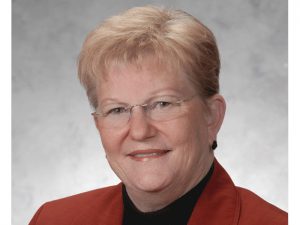
MARINE LOG recently had an opportunity to sit down with Lynne Griffith, the new Assistant Secretary of Washington State Ferries. In the fall of 2014, Griffith became the first woman to hold the position and is responsible for guiding the 1,900 employees that work at the iconic Washington State Ferries to meet their operational, budgetary, and safety goals.It’s no small task: Washington State Ferries is the largest ferry operation in the U.S., carrying about 22 million passengers annually and about 10 million vehicles between 20 different ports in and around Puget Sound.
Some of the key challenges Griffith faces are renewing the WSF fleet—which has an average age of about 35 years old— modernizing the system’s terminals, and investing in new IT systems to improve efficiency and communications with riders. Like most state-run agencies around the country, the Washington State Department of Transportation was hit hard by the recession, which means a loss of revenue and cuts to services across the board. About 70 percent of the ferry system’s operations are funded by the fare box. By comparison taxpayers in New York fund the entire cost of the Staten Island Ferry.
Although she doesn’t have a maritime background, Griffith is well suited for the role with 35 years in the transportation industry, including her role as CEO at Pierce Transit in Washington State, where she had to face similar budgetary constraints and operational challenges.“I’ve always been connected to public service or serving members of the public through transportation. It’s not quite like the movie, Trains, Planes, and Automobiles, but I’ve really done planes, trains, buses, and boats,” jokes Griffith.She started her professional career at 18 working at a small airline. “I used to dispatch airline equipment from parts of the network within the airline. It was just like dispatching buses or getting crews and vessels ready to go in the morning. There’s a very strong similarity in terms of the technical aspects of getting the mode of transportation ready to serve the public.”
Griffith was invited to participate in the selection for the new WSF head by the state Secretary of Transportation 2014. “But I said no. I couldn’t see the connection. I was getting ready to retire.” What changed Griffith’s mind were two high profile ferry incidents. The first was in July 2014 when the 2,500-passenger, 202-vehicle ferry Tacoma lost power on the Seattle-Bainbridge Island route, which caused lengthy delays for passengers crossing Puget Sound.The second occurred on August 15, 2014, when hundreds of Seahawks fans flocked to the ferry to attend a preseason game at CenturyLink Field. After setting sail for Seattle, the Cathlamet had to return to the Bremerton dock to unload 484 passengers because of fears of overloading. However, an official state inquiry ordered by Washington State Department of Transportation Secretary Lynn Peterson found that the vessel was not overloaded, but rather that the count was wrong due to a faulty counting device.
“After those incidents, it dawned on me that Washington State Ferries needed to focus on its operations. And that’s my background—operations. Whether it’s the airline industry or the transit industry, I have always been on the operating end.” Griffith knew she could help. She contacted the state and threw her name back into the hat.Hired back in September 2014, Griffith knew she had to quickly become deeply engaged in the organization in order to assess what exactly needed fixing. That meant learning what agents do at the terminal, deck hands on board, captains in the pilothouse and engineers in the engine room.
“That was the first smart thing I did. The willingness of employees to be candid and open with me really helped me understand what’s working, what’s not working, so that wherever I was going to apply to my leadership role in this organization, I was going to apply it to the right areas. They helped me tremendously to understand where the attention is needed.”As part of the learning process, she took ordinary seaman training. “That was a real eye opener in terms of just how tough their jobs are. They have to be prepared for everything from fire fighting to CPR.”
“As a leader, you have to understand what your employees do and how good they have to be at their jobs, and what their needs are.” Griffith says that insight provides her with the valuable raw knowledge to inform state legislators where funding is needed whether it is for training, maintenance or new hires.“It is hard to sell, that message, when you are in a distressed financial environment. Of course, everyone in the public sector has been grappling with that for a very long time. The recession is long over, but to rebuild that capacity … is a big climb up a very steep ladder,” she adds.
A high priority for Griffith has been a renewal of the aging fleet, as well as renovations to two of the system’s busiest terminals. Washington State Ferries signed a Notice to Proceed giving shipbuilder Vigor Industrial the go ahead to get started on work on the fourth vessel in the 144-vehicle capacity, Olympic Class ferry series and work will begin this month.
The new ferry is funded through the Connecting Washington transportation package, which is being paid for through a hike in state gasoline taxes.
WSF is building the Olympic Class ferries to replace some of the fleet’s oldest vessels. The Olympic Class design is based on the Issaquah class, the most versatile vessel in the WSF fleet.

Two of four are in service, the third will be complete in 2017 and the fourth is scheduled for completion in 2018. The first vessel, Tokitae, joined the Mukilteo/Clinton route in June 2014. The second, Samish, was put into service on the Anacortes/San Juans Island route in June 2015. Chimacum, the third ferry, will replace one of the older vessels on the Seattle/Bremerton route in 2017.
The budget to build the vessel is $122 million, and delivery is scheduled for mid-2018.“I actually think that the build program needs to move on beyond the Olympic Class. Right on the back of the group of new vessels, we have a whole group in our existing fleet that is going to hit 60 years old. We need to be thinking about how we are going to pursue those replacements. What are those vessels going to look like? Are they the same Olympic Class vessel or are they going to be different. We are going to have to think about the funds for those vessels, so we don’t have an interruption in the build program.”
“Technology changes so quickly. Do we need to build ferries that last 60 years or should they be something else? Vessels that are built to last 60 years are more expensive to construct. I don’t know what the answer is, but we have to open ourselves up to thinking about those things.” She notes that some of the older vessels will have to be retained as surge or back up capacity.
WSF, however, will have to compete with the Coast Guard, Navy, and a number of commercial operators for access to regional shipyards, whether it is for drydockings or dockside repairs. Griffith is working closely with Matt Von Ruden, the new Director of Vessels at WSF, on innovative ideas to improve operations.
“Anything from expanding engine room training to collaborating with our shipyard partners in finding solutions for getting our vessels in for inspection or for those big fixes.“Looking at it as a newcomer, I don’t think that replacing every terminal, building every new vessel or adding to the fleet is financially feasible right now. The mistake is that we report that we can do more and more and more without the funding dynamics changing.
“The public is never going to tolerate that much tax. So how can we be smart? What technology can we use? What practical design can we use that gives people what they need?“If you look at it differently and open up your mind—we’re already thinking about different types of fuel that could offer savings for the state if there would be a fuel spike again down the road, about how we can fix and modernize terminals instead of rebuilding at the maximum cost—we can get there with a balance of what the public thinks is acceptable and what we can afford.”
Griffith sees her port engineers, captains, deck hands, and mates as a valuable source of new ideas. “We have one staff chief who thought of an idea to save about $2 million per year just on his route.” That involved modifying operational practices as the ferry came into dock. Instead of using all engines before docking, using just three engines to slow the vessel as it approaches the dock, then two engines when docking. The practice cut the amount of fuel burned.
She also worked with the union to provide more transparency in the service’s Ferry Alerts. With more informative alerts, riders can now make better decisions on whether they should go to the dock or find alternate routes during service disruptions. “If we don’t give enough information, we just made an angry customer.” says Griffith.
While Washington State Ferries has shelved the idea of converting one of its older vessels to hybrid propulsion, it is moving ahead with the idea of burning Liquefied Natural Gas (LNG) as a marine fuel. Griffith would prefer incorporating the technology into a newbuild, but sees the benefits of converting an existing vessel to burn LNG.“There is a lot of apprehension about LNG. There have been questions about whether converting a vessel is practical. What I see is that our experts are going to learn something in that process. We will learn about logistics and how the vessels would be fueled so that, if we make a major investment in a new vessel, we would be a little bit smarter.”
Besides renewing its fleet, WSF also needs to attract new blood to its organization. Griffith points out that the average age of pilot house personnel is 65 and the average age of engine room personnel is 55. “We need a mentoring program right now before we lose the talent. We need to work with local maritime schools and conduct an outreach to local mariners.
“The state does not pay competitively to the private sector. We have to build a package of information to convey the idea of why they should come to work for us. Some of the key benefits of working at Washington State Ferries, however, is that employees have an improved quality of life; the ability to go home at night to their families and long-term security.”
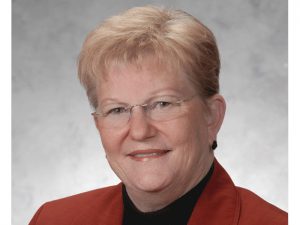
MARINE LOG recently had an opportunity to sit down with Lynne Griffith, the new Assistant Secretary of Washington State Ferries. In the fall of 2014, Griffith became the first woman to hold the position and is responsible for guiding the 1,900 employees that work at the iconic Washington State Ferries to meet their operational, budgetary, and safety goals.It’s no small task: Washington State Ferries is the largest ferry operation in the U.S., carrying about 22 million passengers annually and about 10 million vehicles between 20 different ports in and around Puget Sound.
Some of the key challenges Griffith faces are renewing the WSF fleet—which has an average age of about 35 years old— modernizing the system’s terminals, and investing in new IT systems to improve efficiency and communications with riders. Like most state-run agencies around the country, the Washington State Department of Transportation was hit hard by the recession, which means a loss of revenue and cuts to services across the board. About 70 percent of the ferry system’s operations are funded by the fare box. By comparison taxpayers in New York fund the entire cost of the Staten Island Ferry.
Although she doesn’t have a maritime background, Griffith is well suited for the role with 35 years in the transportation industry, including her role as CEO at Pierce Transit in Washington State, where she had to face similar budgetary constraints and operational challenges.“I’ve always been connected to public service or serving members of the public through transportation. It’s not quite like the movie, Trains, Planes, and Automobiles, but I’ve really done planes, trains, buses, and boats,” jokes Griffith.She started her professional career at 18 working at a small airline. “I used to dispatch airline equipment from parts of the network within the airline. It was just like dispatching buses or getting crews and vessels ready to go in the morning. There’s a very strong similarity in terms of the technical aspects of getting the mode of transportation ready to serve the public.”
Griffith was invited to participate in the selection for the new WSF head by the state Secretary of Transportation 2014. “But I said no. I couldn’t see the connection. I was getting ready to retire.” What changed Griffith’s mind were two high profile ferry incidents. The first was in July 2014 when the 2,500-passenger, 202-vehicle ferry Tacoma lost power on the Seattle-Bainbridge Island route, which caused lengthy delays for passengers crossing Puget Sound.The second occurred on August 15, 2014, when hundreds of Seahawks fans flocked to the ferry to attend a preseason game at CenturyLink Field. After setting sail for Seattle, the Cathlamet had to return to the Bremerton dock to unload 484 passengers because of fears of overloading. However, an official state inquiry ordered by Washington State Department of Transportation Secretary Lynn Peterson found that the vessel was not overloaded, but rather that the count was wrong due to a faulty counting device.
“After those incidents, it dawned on me that Washington State Ferries needed to focus on its operations. And that’s my background—operations. Whether it’s the airline industry or the transit industry, I have always been on the operating end.” Griffith knew she could help. She contacted the state and threw her name back into the hat.Hired back in September 2014, Griffith knew she had to quickly become deeply engaged in the organization in order to assess what exactly needed fixing. That meant learning what agents do at the terminal, deck hands on board, captains in the pilothouse and engineers in the engine room.
“That was the first smart thing I did. The willingness of employees to be candid and open with me really helped me understand what’s working, what’s not working, so that wherever I was going to apply to my leadership role in this organization, I was going to apply it to the right areas. They helped me tremendously to understand where the attention is needed.”As part of the learning process, she took ordinary seaman training. “That was a real eye opener in terms of just how tough their jobs are. They have to be prepared for everything from fire fighting to CPR.”
“As a leader, you have to understand what your employees do and how good they have to be at their jobs, and what their needs are.” Griffith says that insight provides her with the valuable raw knowledge to inform state legislators where funding is needed whether it is for training, maintenance or new hires.“It is hard to sell, that message, when you are in a distressed financial environment. Of course, everyone in the public sector has been grappling with that for a very long time. The recession is long over, but to rebuild that capacity … is a big climb up a very steep ladder,” she adds.
A high priority for Griffith has been a renewal of the aging fleet, as well as renovations to two of the system’s busiest terminals. Washington State Ferries signed a Notice to Proceed giving shipbuilder Vigor Industrial the go ahead to get started on work on the fourth vessel in the 144-vehicle capacity, Olympic Class ferry series and work will begin this month.
The new ferry is funded through the Connecting Washington transportation package, which is being paid for through a hike in state gasoline taxes.
WSF is building the Olympic Class ferries to replace some of the fleet’s oldest vessels. The Olympic Class design is based on the Issaquah class, the most versatile vessel in the WSF fleet.

Two of four are in service, the third will be complete in 2017 and the fourth is scheduled for completion in 2018. The first vessel, Tokitae, joined the Mukilteo/Clinton route in June 2014. The second, Samish, was put into service on the Anacortes/San Juans Island route in June 2015. Chimacum, the third ferry, will replace one of the older vessels on the Seattle/Bremerton route in 2017.
The budget to build the vessel is $122 million, and delivery is scheduled for mid-2018.“I actually think that the build program needs to move on beyond the Olympic Class. Right on the back of the group of new vessels, we have a whole group in our existing fleet that is going to hit 60 years old. We need to be thinking about how we are going to pursue those replacements. What are those vessels going to look like? Are they the same Olympic Class vessel or are they going to be different. We are going to have to think about the funds for those vessels, so we don’t have an interruption in the build program.”
“Technology changes so quickly. Do we need to build ferries that last 60 years or should they be something else? Vessels that are built to last 60 years are more expensive to construct. I don’t know what the answer is, but we have to open ourselves up to thinking about those things.” She notes that some of the older vessels will have to be retained as surge or back up capacity.
WSF, however, will have to compete with the Coast Guard, Navy, and a number of commercial operators for access to regional shipyards, whether it is for drydockings or dockside repairs. Griffith is working closely with Matt Von Ruden, the new Director of Vessels at WSF, on innovative ideas to improve operations.
“Anything from expanding engine room training to collaborating with our shipyard partners in finding solutions for getting our vessels in for inspection or for those big fixes.“Looking at it as a newcomer, I don’t think that replacing every terminal, building every new vessel or adding to the fleet is financially feasible right now. The mistake is that we report that we can do more and more and more without the funding dynamics changing.
“The public is never going to tolerate that much tax. So how can we be smart? What technology can we use? What practical design can we use that gives people what they need?“If you look at it differently and open up your mind—we’re already thinking about different types of fuel that could offer savings for the state if there would be a fuel spike again down the road, about how we can fix and modernize terminals instead of rebuilding at the maximum cost—we can get there with a balance of what the public thinks is acceptable and what we can afford.”
Griffith sees her port engineers, captains, deck hands, and mates as a valuable source of new ideas. “We have one staff chief who thought of an idea to save about $2 million per year just on his route.” That involved modifying operational practices as the ferry came into dock. Instead of using all engines before docking, using just three engines to slow the vessel as it approaches the dock, then two engines when docking. The practice cut the amount of fuel burned.
She also worked with the union to provide more transparency in the service’s Ferry Alerts. With more informative alerts, riders can now make better decisions on whether they should go to the dock or find alternate routes during service disruptions. “If we don’t give enough information, we just made an angry customer.” says Griffith.
While Washington State Ferries has shelved the idea of converting one of its older vessels to hybrid propulsion, it is moving ahead with the idea of burning Liquefied Natural Gas (LNG) as a marine fuel. Griffith would prefer incorporating the technology into a newbuild, but sees the benefits of converting an existing vessel to burn LNG.“There is a lot of apprehension about LNG. There have been questions about whether converting a vessel is practical. What I see is that our experts are going to learn something in that process. We will learn about logistics and how the vessels would be fueled so that, if we make a major investment in a new vessel, we would be a little bit smarter.”
Besides renewing its fleet, WSF also needs to attract new blood to its organization. Griffith points out that the average age of pilot house personnel is 65 and the average age of engine room personnel is 55. “We need a mentoring program right now before we lose the talent. We need to work with local maritime schools and conduct an outreach to local mariners.
“The state does not pay competitively to the private sector. We have to build a package of information to convey the idea of why they should come to work for us. Some of the key benefits of working at Washington State Ferries, however, is that employees have an improved quality of life; the ability to go home at night to their families and long-term security.”